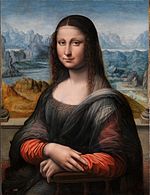Today in class of social sciences we had to have finished the proyects. The teacher have started to ask to the groups some questions about the renaissance art. First she have asked to the group of Inés, Amalia and Fernando who is Michelangelo and more others questions. Then she have asked to Débora and I the main features of the renaissance art, the characteristics of the architecture, sculpture and painting, the main center of Quattrocento and Cinquecento and theirs more important patrons. Later she have ask to the other groups.
The rest of the class there was very interesting because we were looking a lot of images in the whiteboard about architectural elements elements like the the Basilica of Saint Peter in Rome and the Church of San Lorenzo in Florence. We can also have seen a lot of paintings like The School of Athens, Primavera, Birth of Venus and more others, but in this class we have talked a lot about The Mona Lisa or Gioconda. The teacher have explained us that Leonarado Da Vinci, the man who paint this painting, had a pupil or partner who also painted a Mona Lisa but a little bit different, this one were more clear and have more different details.

Source: http://losgrandesrobosdearte.wordpress.com/2011/11/01/quien-se-atrevio-a-robar-la-gioconda/

Source: http://es.wikipedia.org/wiki/La_Gioconda
And during the class we also have copied some words in the glossary, are these:
Contest: concurso.
Vanishing point: punto de fuga.
Paraglider: parapente.
X-rays: rayos X.
Androgynous: androgino.
Rider: jinete.
Rampant: rampante.
Bye!
3 comments:
Hi Camila!
Your journal is very good, you have written some nice Renaissance works that I like. But there's a objection, you have to correct the present perfect tense (especially the verb to have) but except this, your journal is very interesting because of the photos and its sources.
See you!
Hello,
These are my corrections and comments.
Remember to erase the words in brackets and correct what you have in bold font. AS your classmates have said, you have a problem with the third person of the present perfect, which is "has":
- we had to have our projects finished (the proyects).
- The teacher has started to ask (to the groups) some questions about the Renaissance art to the groups. Pay attention to the word order: first Direct Complement, after Indirect complement and later, complements of place, manner and time.
- she has asked
- who (is) Michelangelo is and more other(s) questions. Then she has asked the main features of the Renaissance art to Débora and I.
- and their(s) more important
- ater she has asked
- The rest of the lesson has been very interesting, because we have been watching a lot of images about architectural (elements) elements on the whiteboard
- We (can also) have also seen
- The names of the works of art have to be written in Italic font: The School of Athens, Primavera, Birth of Venus
- The teacher has explained
-...he man who painted this
painting
- his one was clearer and has more different details.
- And during the lesson we have also copied some words on the glossary, which are these
- andrógino.
That's all. REview and correct what I've told you. Bye!
One last thing: Add two labels: the one of your group (4th ESO C-D) and another one with your name.
Post a Comment